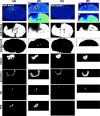Multimodal imaging of hemorrhagic transformation biomarkers in an ischemic stroke model
- PMID: 35254441
- PMCID: PMC9056027
- DOI: 10.1093/mtomcs/mfac007
Multimodal imaging of hemorrhagic transformation biomarkers in an ischemic stroke model
Abstract
Hemorrhagic transformation of ischemic stroke has devastating consequences, with high mortality and poor functional outcomes. Animal models of ischemic stroke also demonstrate the potential for hemorrhagic transformation, which complicates biochemical characterization, treatment studies, and hinders poststroke functional outcomes in affected subjects. The incidence of hemorrhagic transformation of ischemic stroke in animal model research is not commonly reported. The postmortem brain of such cases presents a complex milieu of biomarkers due to the presence of healthy cells, regions of varying degrees of ischemia, dead and dying cells, dysregulated metabolites, and blood components (especially reactive Fe species released from lysed erythrocytes). To improve the characterization of hemorrhage biomarkers on an ischemic stroke background, we have employed a combination of histology, X-ray fluorescence imaging (XFI), and Fourier transform infrared (FTIR) spectroscopic imaging to assess 122 photothrombotic (ischemic) stroke brains. Rapid freezing preserves brain biomarkers in situ and minimizes metabolic artifacts due to postmortem ischemia. Analysis revealed that 25% of the photothrombotic models had clear signs of hemorrhagic transformation. The XFI and FTIR metabolites provided a quantitative method to differentiate key metabolic regions in these models. Across all hemorrhage cases, it was possible to consistently differentiate otherwise healthy tissue from other metabolically distinct regions, including the ischemic infarct, the ischemic penumbra, blood vessels, sites of hemorrhage, and a region surrounding the hemorrhage core that contained elevated lipid oxidation. Chemical speciation of deposited Fe demonstrates the presence of heme-Fe and accumulation of ferritin.
Keywords: FTIR imaging; Fe speciation; XFI; hemorrhage; oxidative damage; stroke.
© The Author(s) 2022. Published by Oxford University Press.
Conflict of interest statement
The authors declare no conflicts of interest.
Figures






References
-
- van Asch C. J. J., Luitse M. J. A., Rinkel G. J. E., van der Tweel I., Algra A., Klijn C. J. M., Incidence, case fatality, and functional outcome of intracerebral haemorrhage over time, according to age, sex, and ethnic origin: a systematic review and meta-analysis, Lancet Neurol., 2010, 9 (2), 167–176. - PubMed
-
- Hansen A. J., Nedergaard M., Brain ion homeostasis in cerebral ischemia, Neurochem. Pathol., 1988, 9, 195–209. - PubMed
Publication types
MeSH terms
Substances
Grants and funding
LinkOut - more resources
Full Text Sources
Medical

